
Official Edgar Rice Burroughs Tribute and Weekly Webzine Site
Since 1996 ~ Over 15,000 Webpages in Archive
Volume 1714
Presents

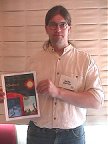 |
An Artist Journal Volume III Tarzan of the Apes By David Burton |
CONTENTS
|
Part
8: Mangani
|
Part 8: An Artists Journal: Tarzan of the Apes - Mangani By David Burton
This is a dream job. Not that Princess wasn't but I've been a Tarzan fan since I was six and saw Tarzan for the first time. That was the Ron Ely television show back in the '60s. I was so enthralled that I recall begging my father to buy me a copy of the abridged Whitman, Tarzan of the Apes with the promise that I would read the whole thing on my own. I did and I was hooked.So this job was something that I never really thought would happen: To illustrate one of the greatest adventure stories of all time! Something that I had always wanted to do. I had drawn Tarzan for as long as I could remember. I even drew my own Tarzan comic books at the ripe old age of seven.
Some might see the early stage of this type of job as hard and unnecessary but research and design can be fun and offer challenges that bring you to new ideas and concepts.
When I started this I had a few things that I wanted; One, to have the same sense of realism that I had given A Princess of Mars. Two, I wanted the apes that raise Tarzan to be different from what had previously been done. They're not chimps or gorillas and they're not some hybrid of the two. I've never seen anyone other than Boris portray them as being a different species. In my design, their faces aren't as anthropoid-like. I've given them more of a Neanderthal appearance. This is due to the fact that they have a spoken language. In order for them to speak, they can't have the jaw that an anthropoid does.
I can't tell you how many designs I went through trying to get the look that I finally settled upon. I kept coming up with designs that had them looking too much like a gorilla or chimp. But when I got it, it was like a light going on and I knew that I was on track.
Leanta Books will be releasing, Tarzan of the Apes with a full Ape Language dictionary as well as a map of Tarzan's Africa (the first time in print for both in nearly twenty years) in January 2007. Exclusives available to Leanta Book Members. Watch for their upcoming Edgar Rice Burroughs t-shirt and tote bag.
Part 9: An Artists Journal: The Design of Tarzan By David Burton
The first image of Tarzan showed him as being very thin. Some might say lean, but I can't see anyone built like that fighting anything off. Now there's a problem with that. It has to do with how we see things. We know that physical strength is not what is seen. For example: Bruce Lee, very lean and incredibly strong. Yet seeing him for the first time you'd never know what power he truly processed. I'd thought of portraying Tarzan this way, based on Bruce Lee actually but didn't. It goes back to "how" we see things. I didn't want Tarzan looking like he works out at Gold's Gym three hours a day, so the bodybuilder look was never in contention. I wanted him to look strong and powerful and didn't want him looking as though he took steroids. I went with the look of old time strong men and bodybuilders, which was completely different from what we know today. The "V" from the waist to shoulders isn't there, the over sized muscles don't exist and the sense that this was what writers such as Burroughs and Robert E. Howard were thinking when they'd write of their heroes' physiques was right on target. Builds that spoke of strength, speed and the look of a tiger were there.
As for his hair, I felt that it should have been really long at first. From an early age, until he's in his late teens at least, before he started cutting it. I have it cut to the time period by the end of the book. Though my plans are to have his hair reflect his inner self when I start illustrating, "The Return of Tarzan". By then, he's been living in the "civilized" world for a while and he's not happy with it. He's a child of the wild and that's something that is always there, something that has shaped him and made him who he is. We wouldn't want him any other way. So by the time we meet him in France at the start of that book, he's wearing his hair a little longer, though combed back. By the time that books ends, he hasn't cut it for a long time and it's going to be back to where he was before he started cutting it himself.
The other thing that's always struck me is how when people do cut their hair, it's always for self defense. This is funny to the point of being a sad stereotype. When has the length of someone's hair helped them in a fight? There are bikers and countless others who had long hair and fought and it was never a problem. Many wore their hair long to show their strength and power in combat, look at the Native Americans for a perfect example.
To say that ERB was forming his hero into what would be most appealing for the time that this story was written wouldn't be far from the mark. If written today, he'd have a different look entirely. So I'm going to give him the look that he'll have for the rest of the series in the books that I illustrate. This will be one that will show to anyone who sees him, that he is a wild man who wears his civilization as nothing more than his clothes. And that's how Tarzan described himself.
Next, the Africa that we know and the one that Burroughs writes collide.
|
The Design of Tarzan
|
![]()
End
of Volume III Part 9
![]()
As we all know, ERB's Africa has little to do with the real Africa. His is set in a fantasy world that borders reality. The problem that new readers have is that they know what the real Africa is like. Sadly, it's mostly desert with very little jungle left and what mysteries it once had have all been revealed. Lions don't wander the jungle and civilization has tainted the land. There is very little room for anything wild to live anymore. Making ERB's Africa look like it could be real takes some sleight of hand. I've done little things like change the Mangani enough so that they don't look like a gorilla or chimp, they're their own species. I've got plans to alter some things and keep others as they are written. I'm going to play with it and ask the viewer to see the fantastic, to stretch their imaginations and try to see ERB's Africa as he wrote it.
It's amazing that when ERB wrote this series there was virtually nothing known about apes. Today, his Mangani seem like a cross between what we now know of gorillas and chimps. They have the same habits, the same diets, use tools and show a greater intelligence than what was given them in the past.
Now we enter a new world where young children know more about the world than we did at their age. We are making it harder to suspend belief. A friend of mine recently was telling how he sat down to watch the original, "King Kong" with his 9-year-old daughter. She kept going on about how Kong wasn't a silver back and how he wasn't acting like a real gorilla. Fantasy and science fiction all have to have a sense of realism in them in order for them to be believed. Gone are the days when a writer or film maker could create a creature or world in which their world, creatures or science could have nothing to do with reality.
For my next installment, what would Tarzan have carried.
|
Tarzan Roughs 


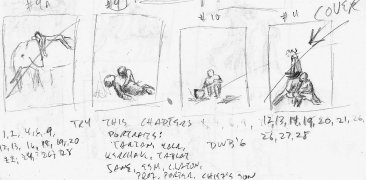
|
When I started this I had these images in my head of what Tarzan's knife and bow would look like. I had these due to what the movies and television shows had shown him carrying. And boy was I off and were they wrong! Now think of this: when Tarzan starts using a bow, he's in the jungle; now when have you ever seen a long bow being used in the jungle? They aren't and they're useless. You've got trees everywhere, branches getting in your way and leaves, thousands of them all over the place. What I did was start by looking at what natives of the African jungle use. They have these little bows that are approximately two to two and a half feet in length. Their arrows are about one to one and a half feet long. They use heads which are light and barbed. The use of poison on them is so that they don't have to chase or hunt down what they've shot since their arrows alone for the most part do not bring about immediate death.
Volume III Part 11: An Artist Journal ~ What Would Tarzan Really Have Carried?
Now his knife. That was a problem. Was the knife something that Lord Greystoke brought along with him or was it something that was given him when they were marooned? I felt that bringing along something like a big hunting knife would be something that he would bring with him, so what kind of knife did they use in Britain at that time? What I came across is something that was common and what I think would have been the knife that he would have brought along.
When Tarzan finds it, it has been in its sheath for about ten years. That sheath would have been rotting. He would have removed the knife and thrown away the sheath. Carrying it on his hip and resting in a belt. Now that belt wouldn't be in great shape and he would have to replace it. That's why he's been taking them as needed from the natives near by. Now let's look at the uses he put that poor knife to. His using it to cut things and stab them, that's a lot of use over the ten or so years that he's got had it before the Porters arrive. I'm thinking that it would get dull fast and often. He'd be watching the natives and would learn that they sharpen their knives and he would follow suit. So he'd be stealing sharpening stones and learning how to use them along with those arrows and bows that he would be stealing.
As for the ornaments, jewelry and such that he's stealing and taking from the natives, I went to work researching what the natives of Central Africa would have. What I found was very interesting. For example, the tribes in that region make some extremely elaborate pieces. They make fancier pieces for celebrations. They use more plain pieces for everyday wear. They will make head dresses that have feathers, though again these are for celebrations, not everyday use. Why the Chief's son has a head dress with feathers on it can only mean that he was undergoing a rite of passage of some sort. He is hunting alone which is also a sign that he was undergoing a rite of passage. Though it's not stated, he could be going through his rite of Manhood. If that's the case, then he's about 13 when he kills Kala. There are other rites that he could be going through; one would be to prove that he's ready to lead his people, in which case hunting down a large animal alone would prove this to his tribe. Since he's older, by about five to ten years, that would mean that his father was old and ready to pass along his leadership. Now Tarzan kills his only son and he's left to lead his tribe for the next ten years alone. If he has another son or tries to, it's never mentioned.
It's mentioned that Tarzan takes the ornaments and headdress. The headdress would prove cumbersome and would lose its beauty within a few days. The ornaments would be changed as he would either get bored with them or they would prove useless. Who wants a bracelet that's making a lot of noise and warning your prey that you're coming?
It's mentioned that he goes without a loincloth until about the time that the Porters arrive. For that, I went with what most tribes seem to have in Central Africa. The men wear small leather pieces in the shape of a rectangle. It's very rare that the native clothing is made of fur unless it's to show something special such as a certain station within the tribe or for a certain celebration.
Next week, we'll look at his parents' cabin.
|
What Would Tarzan Really Have Carried?
|
Volume III Part 12: An Artist Journal ~ The Cabin: Practical Designs
John Clayton was a very capable man. The cabin that he builds is sound and tight. Actually, he did a better job than most people would have. His cabin is layered in mud, nearly four inches in a stucco fashion. This makes for a nice cool place to live. His layout was sound as he was planning on building additions. Though work on these seemed to end once Lady Alice had her breakdown. I don't believe that he would have needed much as far as tools went. I also don't believe that the crew of the Fuwalda would have given him much. He could have built everything with nothing more than a hatchet. I recall an episode of "The Woodwright's Shop" that ran on PBS several years ago, hosted by Roy Underhill. He worked with antique tools and used them to build all sorts of things. The episode was three hours long and live and in that time, with nothing but a hatchet and himself, he build a small cabin. That's how I felt Sir Clayton would do it. Though not in three hours.
I feel that Clayton would have built a square structure about 15 x 15 ft. That's how I took it and made a blueprint of it so that I could figure out where the bed, table and so on would go.
I had a lot of fun with the cabin and hope that I've done it justice.
Next, I outfit the Porters
|
The Cabin: Practical Designs 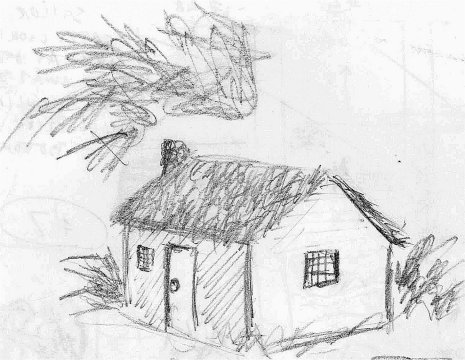
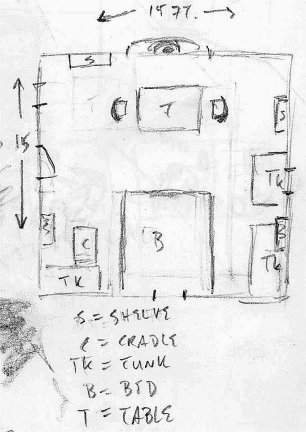
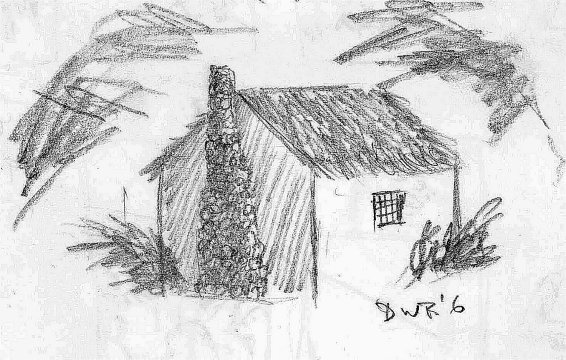 |
![]()
End
of Volume III Part 12
.
. . to be continued next week with Part 13 Outfitting the Porters
![]()
DAVID
BURTON WEB REFS
See
Volume I in ERBzine 1698
See
Volume II in ERBzine 1708
See
the Official David Burton Website
ERBzine
Artist Profiles Series Presents David Burton
![]()

![]()
BILL
HILLMAN
Visit
our thousands of other sites at:
BILL
AND SUE-ON HILLMAN ECLECTIC STUDIO
ERB
Text, ERB Images and Tarzan® are ©Edgar Rice Burroughs, Inc.-
All Rights Reserved.
All
Original Work ©1996-2006/2010/2020 by Bill Hillman and/or Contributing
Authors/Owners
No
part of this web site may be reproduced without permission from the respective
owners.